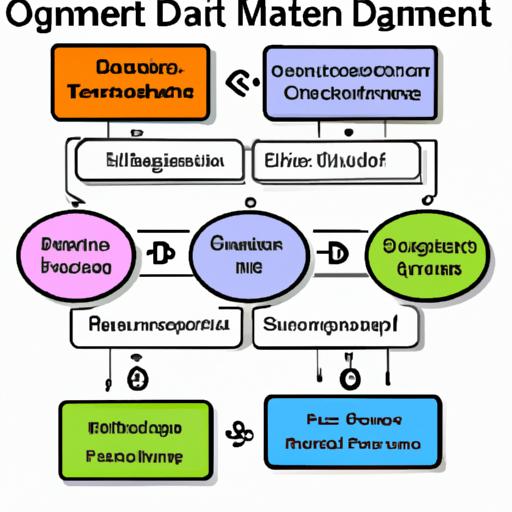Understanding Data Governance

Data analysts understand the significance of data governance and management for business success.
Data governance is the process of managing the availability, usability, integrity, and security of the data used in an organization. It involves the policies, procedures, roles, and responsibilities that ensure that data is managed effectively and meets the organization’s goals and objectives.
Definition of Data Governance
Data governance is the process of managing the availability, usability, integrity, and security of the data used in an organization. It involves the policies, procedures, roles, and responsibilities that ensure that data is managed effectively and meets the organization’s goals and objectives.
Components of Data Governance
An effective data governance program includes several components, including:
- Data policies and standards: guidelines that ensure that data is managed consistently across the organization.
- Data management processes: procedures that outline how data is collected, stored, accessed, and used.
- Roles and responsibilities: clear definition of who is responsible for managing data and ensuring compliance with data policies and standards.
- Data quality management: processes and tools to ensure that data is accurate, complete, and consistent.
- Data security and privacy: policies and procedures that ensure that data is protected from unauthorized access and misuse.
Benefits of Data Governance
Implementing effective data governance provides several benefits, including:
- Improved data quality: ensuring that data is accurate, complete, and consistent.
- Increased efficiency: reducing the time and effort required to manage data.
- Better decision-making: providing accurate and timely data to support decision-making.
- Enhanced compliance: ensuring that data is managed in compliance with legal and regulatory requirements.
- Improved data security: protecting sensitive data from unauthorized access and misuse.
Data Management Best Practices

Securely accessing and managing data anytime, anywhere with mobile devices.
Definition of Data Management
Data management refers to the process of collecting, storing, organizing, and maintaining data. It involves implementing policies, procedures, and practices that ensure the accuracy, completeness, consistency, and security of data. Proper data management is critical for any organization that wants to make informed decisions based on reliable information.
Importance of Data Management
Effective data management is essential for several reasons. First, it helps improve the quality of data by ensuring its accuracy and completeness. Second, it enables organizations to identify and resolve data inconsistencies, redundancies, and errors. Third, it facilitates compliance with regulatory requirements and industry standards. Finally, it supports the efficient use of data by making it easily accessible and understandable to authorized users.
Best Practices for Data Management
To ensure effective data management, organizations should adopt the following best practices:
-
Develop a Data Management Strategy: Establish a clear and comprehensive plan for managing data that aligns with the organization’s goals and objectives.
-
Implement Data Governance: Establish policies, procedures, and practices that ensure the accuracy, completeness, consistency, and security of data.
-
Use Data Standards: Implement data standards that define the format, structure, and content of data to ensure consistency and interoperability.
-
Implement Data Quality Controls: Establish procedures and techniques to monitor and improve the quality of data.
-
Use Data Analytics: Use data analytics tools and techniques to gain insights and identify patterns and trends in data.
Common Data Management Challenges and Solutions
Despite the benefits of effective data management, organizations often face several challenges, including:
-
Data Silos: Data silos occur when data is stored in isolated systems that are not integrated, making it difficult to access and share information. To address this challenge, organizations should establish a centralized data repository and implement data integration strategies.
-
Data Security: Data security is a critical concern for organizations that handle sensitive information. To mitigate the risk of data breaches, organizations should implement data security controls, such as access controls, encryption, and firewalls.
-
Data Governance: Data governance is a complex process that requires buy-in from stakeholders across the organization. To ensure effective data governance, organizations should establish a governance framework that defines roles, responsibilities, and processes for managing data.
Data Governance Frameworks

Understanding the components of a comprehensive data governance and management framework.
Data governance frameworks are essential for ensuring that your organization’s data is managed effectively and efficiently. There are several popular data governance frameworks that you can choose from, each with its own advantages and disadvantages. In this section, we will provide an overview of these frameworks and help you choose the right one for your organization.
Overview of Popular Data Governance Frameworks
- COBIT (Control Objectives for Information and Related Technology) – This framework focuses on IT governance and provides a comprehensive set of controls and best practices for managing information technology.
- DAMA-DMBOK (Data Management Body of Knowledge) – This framework provides a comprehensive guide to data management and covers all aspects of data governance, including data architecture, data modeling, and data quality.
- ISO 8000 – This framework provides a standard for data quality management and focuses on the accuracy, completeness, and consistency of data.
- TOGAF (The Open Group Architecture Framework) – This framework provides a holistic approach to enterprise architecture and covers all aspects of IT governance, including data governance.
Advantages and Disadvantages of Each Framework
Each framework has its own advantages and disadvantages. For example, COBIT is highly focused on IT governance and may not be suitable for organizations that do not have a large IT department. On the other hand, DAMA-DMBOK is a comprehensive framework that covers all aspects of data governance but may be too complex for smaller organizations.
Choosing the Right Framework for Your Organization
When choosing a data governance framework, it is important to consider your organization’s size, industry, and specific data governance needs. You should also assess the strengths and weaknesses of each framework and choose the one that best aligns with your organization’s goals and objectives.
In conclusion, data governance frameworks are essential for effective data management and governance. By choosing the right framework for your organization, you can ensure that your data is accurate, consistent, and secure.
Importance of Data Security and Privacy
Data security and privacy are critical aspects of effective data governance and management. As businesses collect and store vast amounts of data, the need for robust security measures and privacy policies becomes increasingly crucial. In this section, we’ll explore the importance of data security and privacy and discuss best practices for protecting sensitive information.
Overview of Data Security and Privacy
Data security refers to the measures that organizations take to safeguard their data against unauthorized access, theft, and damage. It involves implementing controls and protocols to ensure that data is protected throughout its lifecycle, from creation to disposal. Data privacy, on the other hand, refers to the policies and procedures that organizations put in place to protect individuals’ personal information. It includes the laws and regulations that govern the collection, use, and sharing of personal data.
Importance of Data Security and Privacy
Data breaches can be devastating for organizations, resulting in significant financial losses, reputational damage, and legal consequences. Moreover, individuals may suffer identity theft, financial fraud, and other harms as a result of their personal data being compromised. Therefore, it is critical to prioritize the security and privacy of data to protect both organizations and individuals.
Best Practices for Data Security and Privacy
To ensure effective data security and privacy, organizations should implement a range of best practices, including:
- Regularly conducting risk assessments to identify vulnerabilities and threats
- Implementing access controls to limit who can access sensitive data
- Encrypting data to protect it from unauthorized access
- Regularly backing up data to ensure it can be recovered in the event of a breach or disaster
- Providing regular training to employees on data security and privacy best practices
By following these best practices, organizations can mitigate the risks associated with data breaches and protect both their data and their customers’ privacy.
Conclusion
In conclusion, data governance and management are critical components of any organization’s strategy. As we have seen, the effective governance of data can help businesses improve operational efficiency, reduce risks, and increase revenue. It can also help organizations comply with legal and regulatory requirements, protect sensitive information, and build trust with customers.
To ensure effective data governance and management, organizations must have a clear understanding of their data assets, establish policies and procedures for managing data, and regularly monitor and evaluate their data governance practices. By doing so, organizations can maximize the value of their data, mitigate risks, and achieve their business objectives.
Remember, data governance and management are ongoing processes that require continuous improvement and adaptation to changing business needs and technological advancements. By prioritizing data governance and management, organizations can position themselves for long-term success and growth.